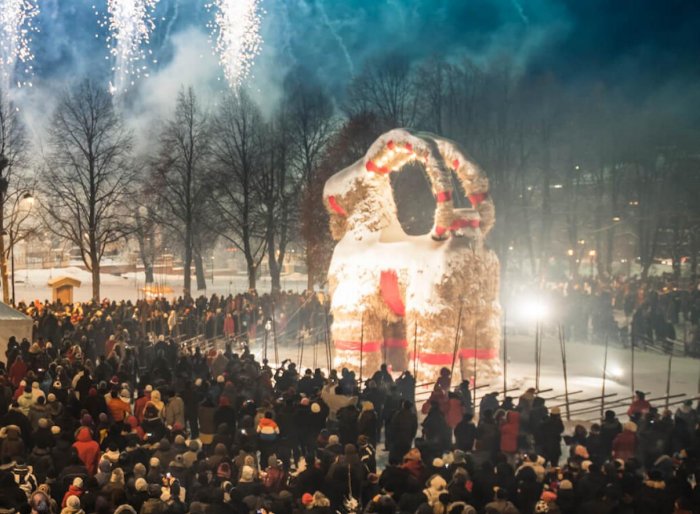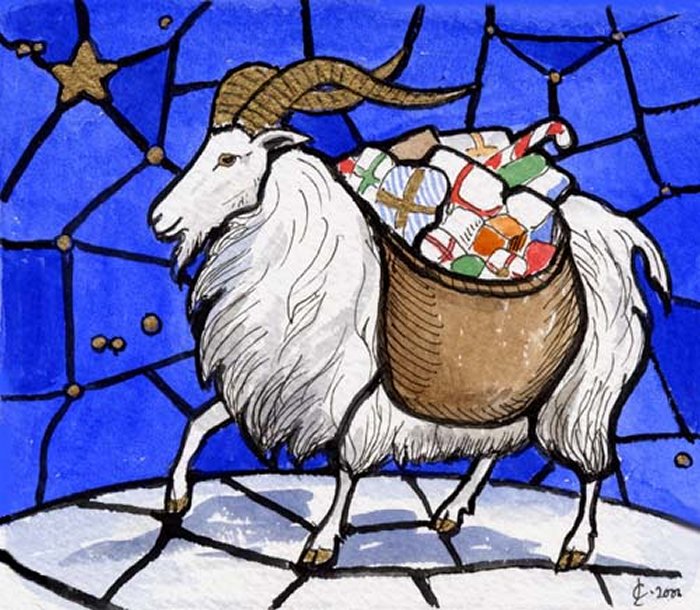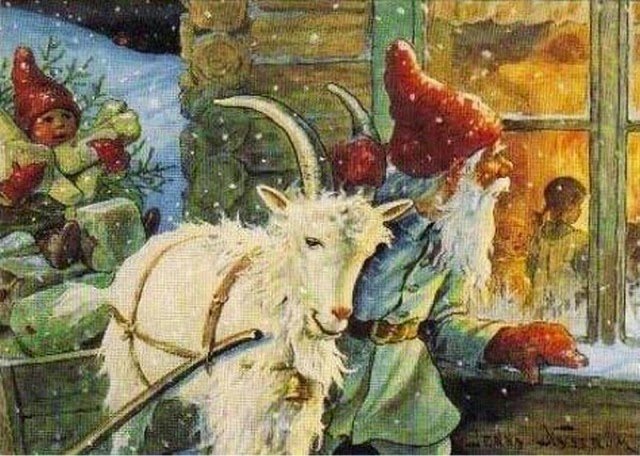Yule Goat Is A Scandinavian Christmas Tradition Based On Norse Legends And Worship Of God Thor
Ellen Lloyd - AncientPages.com -If you ever visit Sweden during Christmas, make sure to go to the city of Gävle, where you can see a colossal goat made of straw standing at Slottstorget (Castle Square).
Yule Goat (Gävlebocken) in Gävle, Sweden. Image credit: Visit Gävle
The giant goat is erected yearly at the beginning of Advent over two days. It's an annual Christmas tradition based on Norse legends and worship of the Thunder God Thor.
According to the Guinness Book of World Records, at 49 feet tall to the upper curve of its horns, the 1993 version of the Gävle goat holds the record for the world's giant straw goat.
The history of the Yule Goat goes back several thousands of years, and many ancient myths and legends show how important this animal was to our ancestors.
In some Norse myths, God Thor was said to be riding a flying chariot drawn by two goats.
The Yule Goat is one of the oldest Scandinavian Yule symbols and traditions.
It was believed that the goats Tanngrisnir ("Gap-tooth") and Tanngnjóstr ("Tooth-grinder"), who pulled Thor's chariot, provided food for the God and his friends.
People in Scandinavia were just some who understood the value of the Yule Goat. Slavic mythology shows us that a white goat represents the Sun God Dazbog. Koliada (Yule), an ancient pre-Christian Slavic winter festival later incorporated into Christmas, started to honor the God of the fertile Sun and the harvest. The Koliada festivals always had a person dressed as a goat, often demanding offerings in the form of presents.
So, the Yule Goat's origins go back to ancient Pagan festivals, and the celebration and beliefs have changed much over the years.
In ancient times, people in Sweden believed that the Yule Goat was an invisible spirit that would appear sometime before Christmas to check if the Christmas preparations had been done correctly.
God Thor and his two goats. Painting by Max Friedrich Koch (1859 - 1930
There was a time when the Yule Goat was considered a demonic and frightening creature that roamed the countryside on the night of December 25, demanding food and frightening devout Christians. It changed with time, and the Yule Goat became a beloved being worshipped all across Scandinavia.
During the 19th century in Scandinavia, the Yule Goat received a similar role to Santa Claus. People dressed as the Christmas Yule Goat and traveled door to door, distributing small gifts to the families they visited.
In time, the role of holiday gift-giving passed to gnomelike, goat-riding Christmas elves called tomten (Sweden), Nissen (Norway), and tonttu (Finland), who delivered gifts to sleeping children like Santa Claus does today.
Variously known as a julbock (Sweden), julebukk (Norway), or olkipukki (Finland), the tradition of making straw goat ornaments during the Christmas season is still alive all across Scandinavia and Northern Europe. Yule goats range in size from tiny ones to tie on the Christmas Tree to the giant goat erected in Gävle.
Illustration by Jenny Nyström, Swedish artist.
The first Gävle Goat was put up on December 1, 1966. Unfortunately, in the last few years, the excellent straw goat has been repeatedly destroyed by vandals. It has been burned down several times, and today, many people feel the goat needs better protection. So, there are even safety cameras monitoring movements around the goat.
Fortunately, the fire station is near where the goat is erected, and, in most cases, they can extinguish the fire before the whole wooden structure is damaged.
Vandals may try to destroy the Yule Goat, but the fact remains that in Sweden, Norway, and Finland, the Yule Goat is as much a part of Christmas tradition as Santa Claus or Frosty the Snowman.
The Yule Goat is simply a significant Christmas symbol in Scandinavia.
Updated on December 1, 2023
Written by Ellen Lloyd – AncientPages.com
Copyright © AncientPages.com All rights reserved. This material may not be published, broadcast, rewritten or redistributed in whole or part without the express written permission of AncientPages.com
Expand for referencesMore From Ancient Pages
-
 On This Day In History: Mount Fuji Erupted – On Dec 16, 1707
News | Dec 16, 2016
On This Day In History: Mount Fuji Erupted – On Dec 16, 1707
News | Dec 16, 2016 -
 New Study Questions Claims Homo Naledi Was Advanced
Evolution | Nov 13, 2023
New Study Questions Claims Homo Naledi Was Advanced
Evolution | Nov 13, 2023 -
 Earliest Fascinating Concepts Of Artificial Intelligence And Robots In Ancient Myths – Examined
Archaeology | Mar 6, 2019
Earliest Fascinating Concepts Of Artificial Intelligence And Robots In Ancient Myths – Examined
Archaeology | Mar 6, 2019 -
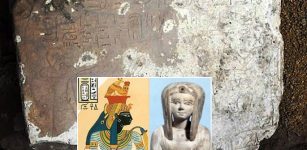 Limestone Stela Of Liberation Discovered In Kom Ombo Temple In Aswan, Egypt
Archaeology | Oct 17, 2018
Limestone Stela Of Liberation Discovered In Kom Ombo Temple In Aswan, Egypt
Archaeology | Oct 17, 2018 -
 Incredible 700-Year-Old Tombs With Beautiful Decorations And Carved Bricks Found In Shandong, China
Archaeology | May 22, 2023
Incredible 700-Year-Old Tombs With Beautiful Decorations And Carved Bricks Found In Shandong, China
Archaeology | May 22, 2023 -
 Mystery Of The Hidden Wooden Hieroglyphic Tablets And The Unknown White Bearded Men – The Civilization That Died Twice – Part 2
Civilizations | Mar 6, 2021
Mystery Of The Hidden Wooden Hieroglyphic Tablets And The Unknown White Bearded Men – The Civilization That Died Twice – Part 2
Civilizations | Mar 6, 2021 -
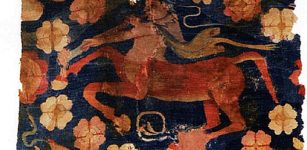 Sampul Tapestry: Mysterious Silk Road Textile Linked To Hellenistic Kingdoms Of Central Asia And Tarim Basin
Artifacts | Nov 21, 2018
Sampul Tapestry: Mysterious Silk Road Textile Linked To Hellenistic Kingdoms Of Central Asia And Tarim Basin
Artifacts | Nov 21, 2018 -
 Zep Tepi – When Gods Established Their Kingdom On Earth In Egypt
Egyptian Mythology | May 23, 2021
Zep Tepi – When Gods Established Their Kingdom On Earth In Egypt
Egyptian Mythology | May 23, 2021 -
 Spectacular Chand Baori Stepwell Of India That Resembles Reversed Pyramid
Featured Stories | Jul 14, 2015
Spectacular Chand Baori Stepwell Of India That Resembles Reversed Pyramid
Featured Stories | Jul 14, 2015 -
 Can Pollen Analysis Solve The Ice Age Mystery How And When Homo Sapiens Migrated Across Europe And Asia?
Archaeology | Sep 23, 2023
Can Pollen Analysis Solve The Ice Age Mystery How And When Homo Sapiens Migrated Across Europe And Asia?
Archaeology | Sep 23, 2023 -
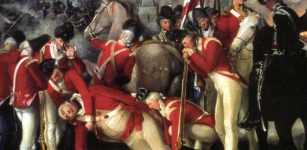 On This Day In History: Irish Rebellion Led By The United Irishmen Against British Rule Begins – On May 24, 1798
News | May 24, 2016
On This Day In History: Irish Rebellion Led By The United Irishmen Against British Rule Begins – On May 24, 1798
News | May 24, 2016 -
 New Underwater Discoveries Made Around The Antikythera Shipwreck
Archaeology | Jul 21, 2023
New Underwater Discoveries Made Around The Antikythera Shipwreck
Archaeology | Jul 21, 2023 -
 12 Ancient Myths, Legends And Biblical Stories Confirmed By Modern Science
Featured Stories | Apr 22, 2017
12 Ancient Myths, Legends And Biblical Stories Confirmed By Modern Science
Featured Stories | Apr 22, 2017 -
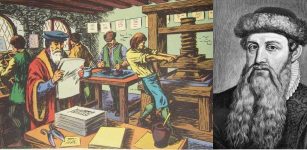 Why Did First Printed Books Scare Ancient Scholars In Europe?
Ancient History Facts | Sep 18, 2021
Why Did First Printed Books Scare Ancient Scholars In Europe?
Ancient History Facts | Sep 18, 2021 -
 These Curious Burials Could Challenge Historians’ Ideas About Anglo-Saxon Gender
Featured Stories | Oct 3, 2023
These Curious Burials Could Challenge Historians’ Ideas About Anglo-Saxon Gender
Featured Stories | Oct 3, 2023 -
 Mythical Helen Of Troy: Beautiful Wife Of King Menelaus Of Sparta
Featured Stories | Jul 5, 2019
Mythical Helen Of Troy: Beautiful Wife Of King Menelaus Of Sparta
Featured Stories | Jul 5, 2019 -
 Who Was The The Mysterious Lady Of Bietikow And What Had She In Common With Ötzi Iceman?
Archaeology | Nov 6, 2020
Who Was The The Mysterious Lady Of Bietikow And What Had She In Common With Ötzi Iceman?
Archaeology | Nov 6, 2020 -
 Sacred Number Six And Its Symbolic Significance In Ancient Cultures
Ancient Symbols | Dec 27, 2017
Sacred Number Six And Its Symbolic Significance In Ancient Cultures
Ancient Symbols | Dec 27, 2017 -
 On This Day In History: Battle Of Ayacucho Was Fought In Peru – On Dec 9, 1824
News | Dec 9, 2016
On This Day In History: Battle Of Ayacucho Was Fought In Peru – On Dec 9, 1824
News | Dec 9, 2016 -
 Migrants From Turkey And Greece Arrived In Britain Some 6,000 Years Ago
Archaeology | Apr 16, 2019
Migrants From Turkey And Greece Arrived In Britain Some 6,000 Years Ago
Archaeology | Apr 16, 2019

